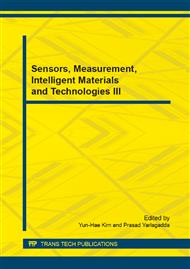[1]
Gardner JW, Bartlett P N. A brief history of electronic nose[J]. Sensors and ActuatorsB, 1994, 18(19): 211 -220.
Google Scholar
[2]
Yu Yong, Wang Jun, Zhou Ming. Electronic nose and its application in processing of agricultural products [J] Journal of Zhejiang University of Agriculture and Life Sciences, 2003, 29 (5): 579-584.
Google Scholar
[3]
Huang Hui, Yang Peng, Jiang Haiqing. Electronic nose-bionic gas measurement systems [J] Sensor Technology, 2003, 22 (1): 1-4.
Google Scholar
[4]
Nanto H, Stetter J R. Introduction to chemossensors[M]/Pearce T C, Schiffan S S, et al. Handbook of machine olfaction: electronic nose technology. Germany:Wiley-VCH, 2003: 506-507.
Google Scholar
[5]
Kalman E L, Lofvendahl A, Winquist F, et al. Classification of complex gas mixture from automotive leather using an electronic nose[J]. Analytica Chimica Acta , 2000, 403(1~2): 31-38.
DOI: 10.1016/s0003-2670(99)00604-2
Google Scholar
[6]
Covington J A, Gardner J W, Briand D et al. A polymer gate fet sensor array for detecting organic vapours [J]. Sensors and Actuators B: Chemical , 2001 , 77(1~2): 155~162.
DOI: 10.1016/s0925-4005(01)00687-6
Google Scholar
[7]
Zhu Jia Jing. The progress development of electronic nose sensor technology [J] Beijing Biomedical Engineering, 2002, 21 (4): 298-301.
Google Scholar
[8]
Gao Xu Ping, Wang Ping. Advances in electronic nose signal processing method [J] Foreign Medical Bio: Volume of Biomedical Engineering, 2001, 24 (1): 1-6.
Google Scholar
[9]
Bourrounet,B.,T. Talou, et al. Application of a multi-gas-sensor device in the meat industry for Boar-taint detection [J]. Sensors and Actuators B: Chemical, 1995, 27(l-3): 250-254.
DOI: 10.1016/0925-4005(94)01596-a
Google Scholar
[10]
Arnold J.W. And S.D. Senter. Use of digital aroma technology and SPME GC-MS to compare volatile compounds produced by bacteria isolate from processed poultry[J]. Journal of the Science of Food and Agriculture ,1998, 38(3):343-348.
DOI: 10.1002/(sici)1097-0010(199811)78:3<343::aid-jsfa124>3.0.co;2-5
Google Scholar
[11]
BarbriN.E.,E. Llobet, et, al. Electronic Nose Based on Metal Oxide Semieonduetor Sensors as an Alternative Technique for the Spoilage Classification of Red Meat[J]. Sensors, 2008, 8: 142-156.
DOI: 10.3390/s8010142
Google Scholar
[12]
Zhang S.P.,C.S. Xie, et al. Spoiling and formaldehyde-containing detections in octopus with an electronic nose[J]. Food Chemistry, 2009, 113(4): 1346-1350.
DOI: 10.1016/j.foodchem.2008.08.090
Google Scholar
[13]
Olafsdottir G.,P. Nesvadba, et al. Multisensor for fish quality determination[J]. Trends in Food Science&Technology, 2004, 15(2): 86-93.
Google Scholar
[14]
Hammond J.,B. Marquis, et al. A semiconducting metal-oxide array for monitoring fish freshness[J]. Sensors and Actuators B, 2002, 84(2-3): 113-122.
DOI: 10.1016/s0925-4005(02)00011-4
Google Scholar
[15]
Brezmes J.,E. Llobet, et, al. Fruit ripeness monitoring using an Electronic Nose[J]. Sensors and Actuators B, 2000, 69(3): 223-229.
DOI: 10.1016/s0925-4005(00)00494-9
Google Scholar
[16]
Natale C.D.,A. Macagnano, et,al. Thee valuation of quality of post-harvest oranges and apples by means of an electronic nose[J]. Sensors and Actuators B, 2001, 78(l-3): 26-31.
DOI: 10.1016/s0925-4005(01)00787-0
Google Scholar
[17]
Defilippi B.G.,W.S. Juan, et. al. The aroma development during storage of Castlebrite apricots as evaluated by gas chromatography, electronic nose, and sensory analysis[J]. Post harvest Biology and Technology, 2009, 51(2): 212-219.
DOI: 10.1016/j.postharvbio.2008.08.008
Google Scholar
[18]
Olsson J.,T. Borjesson, et, al. Detection and quantification of ochratoxin A and deoxynivalenol in barely grains by GC-MS and electronic nose[J]. International Journal of Food Microbiology, 2002, 72(3): 203-214.
DOI: 10.1016/s0168-1605(01)00685-7
Google Scholar
[19]
Paolesse, R.,A. Alimelli, et, al. Detection of fungal contamination of cereal grain samples by an Electronic nose[J]. Sensors and Actuators B, 2006, 119(2): 425-430.
DOI: 10.1016/j.snb.2005.12.047
Google Scholar
[20]
Berna A.Z.,J. Lammertyn, et, al. Electronic nose systems to study shelf life and cultivar effect on tomato aroma profile[J]. Sensors and Actuators B, 2004, 97(2-3): 324-333.
DOI: 10.1016/j.snb.2003.09.020
Google Scholar
[21]
Concina1.,M. Falasconi, et, al. Early detection of microbial contamination in processed tomatoes by electronic nose[J]. Food Control, 2009, 20(10): 873-880.
DOI: 10.1016/j.foodcont.2008.11.006
Google Scholar


